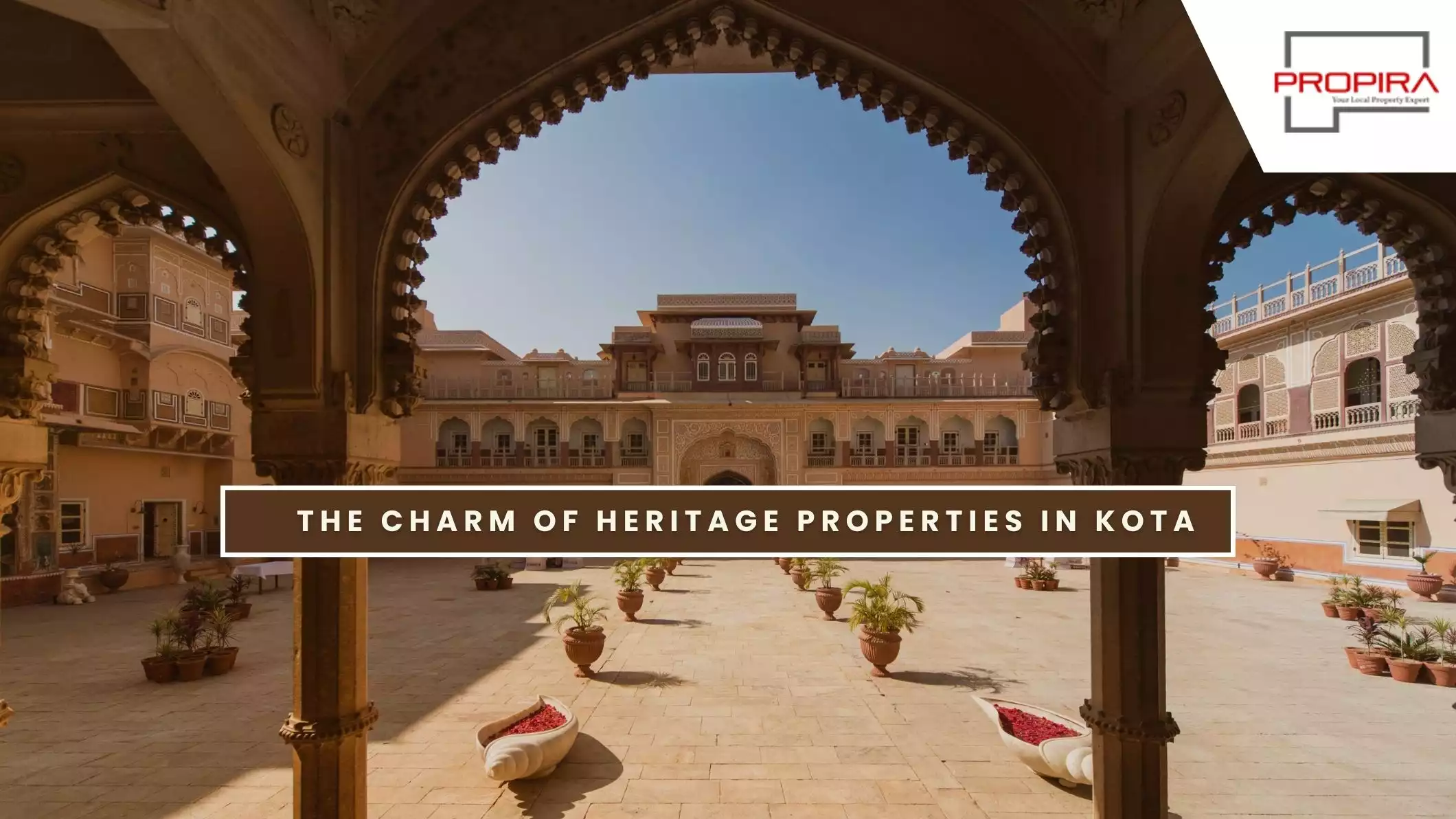
The Charm of Heritage Properties in Kota
The Charm of Heritage Properties in Kota

Kota, a gem in the vibrant state of Rajasthan, India, boasts a rich tapestry of history and culture that dates back centuries. Renowned for its impressive forts, opulent palaces, and the serene Chambal River that flows through it, Kota encapsulates the spirit of Rajput bravery and the artistic legacy of the Mughal era. Beyond its historical monuments and natural beauty, Kota has carved out a niche for itself as an educational hub, drawing students from across the country. Yet, it's the city's heritage properties that offer a unique window into its soul, marrying Kota's historical grandeur with architectural splendor.
These heritage properties, ranging from majestic havelis to ancient forts, are not just structures of brick and stone but repositories of stories and traditions passed down through generations. They stand as silent witnesses to Kota's evolution, from a strategic military outpost to a thriving cultural center. Each property, with its ornate facades, intricate frescoes, and grand courtyards, is a testament to the skilled artisans of yesteryears and their mastery over architecture and art. The charm of these heritage properties lies in their ability to transport one back in time, offering a glimpse into the lives of those who once walked their halls.
The allure of Kota's heritage properties extends beyond their aesthetic appeal; they embody the unique charm of Rajasthani architecture, characterized by its fusion of Rajput military architecture and Mughal-inspired gardens and pavilions. This architectural blend, coupled with the tales of valor and tradition they encapsulate, makes these properties more than just historical landmarks; they are cultural beacons that continue to draw visitors and admirers from around the world.
Historical Background of Kota
The history of Kota begins in the 12th century when it was part of the territory of Bundi, another princely state in Rajasthan. However, Kota carved its distinct identity in 1631 when Rao Madho Singh, the second son of Rao Ratan Singh of Bundi, was granted the region by the Mughal Emperor Jahangir. This event marked the birth of Kota as a separate princely state, setting the stage for its rise as a prominent center of politics, culture, and architecture in the region. Under the rule of its Rajput kings, Kota not only flourished as a military stronghold but also as a patron of arts and culture, drawing artists, craftsmen, and architects from across the country.
Cultural Significance of Heritage Properties
Living in heritage properties in Kota offers an unparalleled experience that goes beyond the conventional bounds of residential living. It’s an immersion into a world where historical luxury and architectural grandeur of the past meet the comfort and conveniences of the present. This unique blend of old-world charm and modern living appeals to those who cherish history and appreciate the beauty of detailed craftsmanship.
Case Studies of Restored Heritage Properties in Kota
The restoration and repurposing of heritage properties in Kota have become exemplary projects, showcasing the potential to breathe new life into historical structures while preserving their cultural essence. These case studies not only highlight the architectural and historical significance of such endeavors but also shed light on the intricate process of restoration, the challenges faced, and the remarkable outcomes achieved.
Example 1: The Haveli Transformation
One notable example is the transformation of a 19th-century haveli into a boutique hotel. This property, once in a state of disrepair, was meticulously restored over several years. The restoration process involved not only structural reinforcements but also the revival of traditional frescoes and carvings that had faded over time. Modern amenities were seamlessly integrated into the haveli, ensuring comfort without compromising its historical integrity. The project faced challenges, including sourcing authentic materials and skilled artisans capable of traditional craftsmanship. The outcome was a stunning fusion of Kota's rich heritage with contemporary luxury, offering guests a unique glimpse into the city's past.
Example 2: The Fort Revival
Another significant project was the revival of an ancient fort on the outskirts of Kota. The fort, which had witnessed centuries of history, was repurposed into a cultural center and museum. The restoration focused on stabilizing the structure, restoring battlements, and recreating the original landscaping. One of the major challenges was the fort's sheer size and the need to adhere to strict conservation guidelines. The successful outcome not only preserved an important piece of Kota's history but also created a space for cultural engagement and education, attracting both locals and tourists.
Insights into the Restoration Process
These case studies reveal critical insights into the restoration process of heritage properties. Firstly, a deep understanding of the historical and cultural significance of each structure is essential. This knowledge guides the restoration efforts, ensuring that any interventions are sympathetic to the original architecture. Secondly, the challenges of restoration are multifaceted, ranging from structural stabilizations to the preservation of artistic elements and the integration of modern functionalities. Overcoming these challenges requires a collaborative approach, involving historians, architects, artisans, and conservationists.
Outcomes and Impact
The outcomes of these restoration projects extend beyond the physical structures themselves. They contribute to the preservation of Kota's cultural heritage, offer new purposes for historical buildings, and stimulate local economies through tourism and employment opportunities. Furthermore, these successful restorations serve as inspiring models for similar projects, highlighting the viability and value of preserving heritage properties.
Navigating the Heritage Property Market in Kota
Navigating the heritage property market in Kota requires a nuanced understanding of the historical, architectural, and cultural value these properties embody. For prospective buyers enchanted by the allure of owning a piece of history, a careful approach to valuation, authenticity, and potential is essential. Here are key insights and tips to guide those interested in the heritage property market in Kota.
Understanding the Value
Historical Significance: Evaluate the property’s historical importance. Properties with a storied past or those associated with significant events or figures in history often hold greater value.
Architectural Integrity:- Assess the architectural authenticity and integrity of the property. Original features such as frescoes, carvings, and architectural details add to the property's value and appeal.
Legal Clearances:- Ensure that the property has clear legal titles and is free from disputes. Heritage properties can sometimes have complex ownership histories, making legal due diligence paramount.
Assessing Authenticity
Research and Documentation: Conduct thorough research on the property's history and architecture. Official records, old photographs, and historical texts can provide insights into its authenticity.
Expert Consultation:- Engage with historians, architects specialized in heritage conservation, and legal experts familiar with heritage properties to verify authenticity and understand any restoration work done.
Conservation Guidelines:- Familiarize yourself with local and national heritage conservation guidelines. Authentic restoration and preservation efforts in line with these guidelines enhance the property's cultural value.
Evaluating Potential
Restoration and Maintenance: Consider the costs and effort required for restoration and ongoing maintenance. Heritage properties can require significant investment to restore and maintain modern living standards while preserving historical integrity.
Adaptive Reuse Opportunities:- Explore the potential for adaptive reuse. Many heritage properties in Kota have been successfully transformed into boutique hotels, cultural centers, and commercial spaces, offering lucrative returns on investment.
Cultural and Economic Impact:- Reflect on the property’s potential to contribute to the local culture and economy. Heritage properties can play a crucial role in promoting tourism and cultural preservation, adding to their long-term value.
Making an Informed Decision
Prospective buyers should approach the heritage property market in Kota with a blend of passion for history and pragmatism. Assessing the value, authenticity, and potential of heritage properties requires a comprehensive approach, balancing the emotional allure of owning a piece of history with practical considerations of restoration, legality, and investment potential. With the right guidance and due diligence, investing in a heritage property in Kota can be both a tribute to India’s rich cultural heritage and a rewarding venture.
Future of Heritage Properties in Kota
The future of heritage properties in Kota looks promising, buoyed by a growing recognition of their cultural, historical, and economic value. As awareness about the importance of preserving architectural heritage gains momentum, initiatives aimed at conservation and promotion are increasingly coming to the forefront. Coupled with evolving market dynamics and a burgeoning interest in cultural tourism, these efforts are set to redefine the landscape of heritage properties in Kota.
Conservation and Promotion Initiatives
Government and Private Sector Collaboration: A key driver for the future preservation of heritage properties in Kota is the collaboration between government bodies and the private sector. These partnerships are aimed at restoring and maintaining historic structures while ensuring their adaptive reuse in ways that respect their heritage value.
Community Involvement:- Engaging local communities in the conservation process is crucial. By fostering a sense of ownership and pride among residents, initiatives can ensure the sustainable preservation of heritage sites. Community-led tours, heritage walks, and cultural festivals are examples of how the local populace can contribute to promoting Kota’s architectural legacy.
Technological Integration:- The use of technology in conservation efforts is on the rise. From 3D scanning and modeling for structural analysis to digital archiving of historical documents, technology offers innovative solutions for the challenges associated with preserving heritage properties.
Evolving Market Dynamics
Increased Investment Interest: As the intrinsic value of heritage properties becomes more widely recognized, there is a noticeable increase in investment, both from within India and internationally. Investors are drawn to the unique appeal and potential returns of these properties, viewing them not just as real estate investments but as contributions to cultural preservation.
Adaptive Reuse Opportunities:- The market is witnessing a growing trend of adaptive reuse, where heritage properties are repurposed into boutique hotels, cultural centers, cafes, and art galleries. This not only ensures the financial viability of maintaining these structures but also contributes to their ongoing preservation.
Growing Interest in Cultural Tourism
Enhanced Tourist Attraction:- Kota’s heritage properties are becoming key attractions for cultural tourists seeking authentic experiences. The city’s rich history, coupled with its architectural marvels, positions it as a prime destination for those looking to immerse themselves in Rajasthan’s royal past.
Educational and Cultural Experiences:- The promotion of heritage properties as centers for educational and cultural experiences is enhancing their appeal. Workshops, exhibitions, and cultural performances within these historic settings offer visitors insights into Kota’s traditions and history, further stimulating interest in cultural tourism.
In conclusion, the heritage properties of Kota are much more than architectural wonders; they are the heartbeats of the city's rich history and cultural legacy. As we move forward, let us do so with a commitment to not only preserving these irreplaceable jewels of historical real estate but also to celebrating and promoting the unique charm and potential they represent. In doing so, we honor our past, enrich our present, and invest in our future, ensuring that the heritage of Kota remains alive for generations to come.










Write Comment